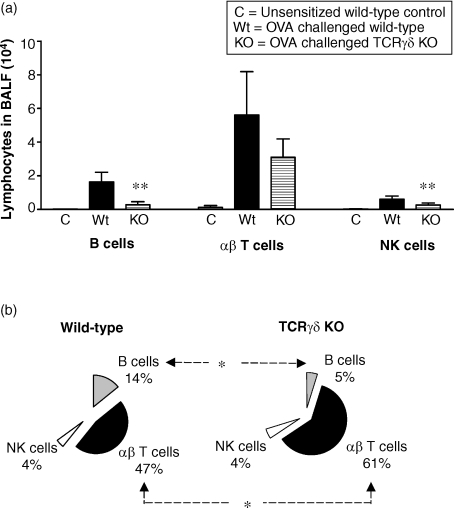Figure 5.
Analysis of lymphocyte subsets in BALF of γδ T cell deficient and wild-type C57BL/6 mice. (a) The total number of B cells (B220+ CD3–), αβ T cells (TCRαβ+) and NK cells (NK1.1+ CD3–) in BALF was analysed by flow cytometry 18 hr after the last of three repeated exposures of aerosolized OVA in presensitized or untreated control mice. In unsensitized control mice receiving only OVA-aerosol challenge, the percentage of lymphocytes was generally less than 2% of the total leucocytes, yielding less than 8000 lymphocytes in 4 ml BALF. Among these lymphocytes, a small but substantial population of αβ T cells was observed while B cells and NK cells were barely detectable. In sensitized and aerosol challenged wild-type mice, a 30-fold increase in BALF lymphocytes was recorded. The increase in BALF total lymphocytes was significantly weaker in mice lacking γδ T cells than in the wild-type strain (P < 0·001 when comparing total number of cells in the lymphocyte population). Mean values and standard deviations are illustrated. (b) The distribution of lymphocyte subsets in BALF of sensitized and aerosol challenged mice was analysed by calculating the proportion of αβ Τ cells, B cells and NK cells among total lymphocytes. Electronic gates were set in the forward/side scatter plot according to standardized procedures for identification of lymphocytes by flow cytometry. Gated cells also included monocytes/macrophages with similar size and granulation as lymphocytes. The appearance of nonlymphocytes among the gated cells was similar in the two strains and did not influence the results. Mean values are shown. Six animals in the OVA treated wild-type and TCRγδ KO groups and two animals in the untreated group. The figure represents one of two experiments with similar results. *P < 0·05; **P < 0·01 versus the OVA challenged wild-type group.

